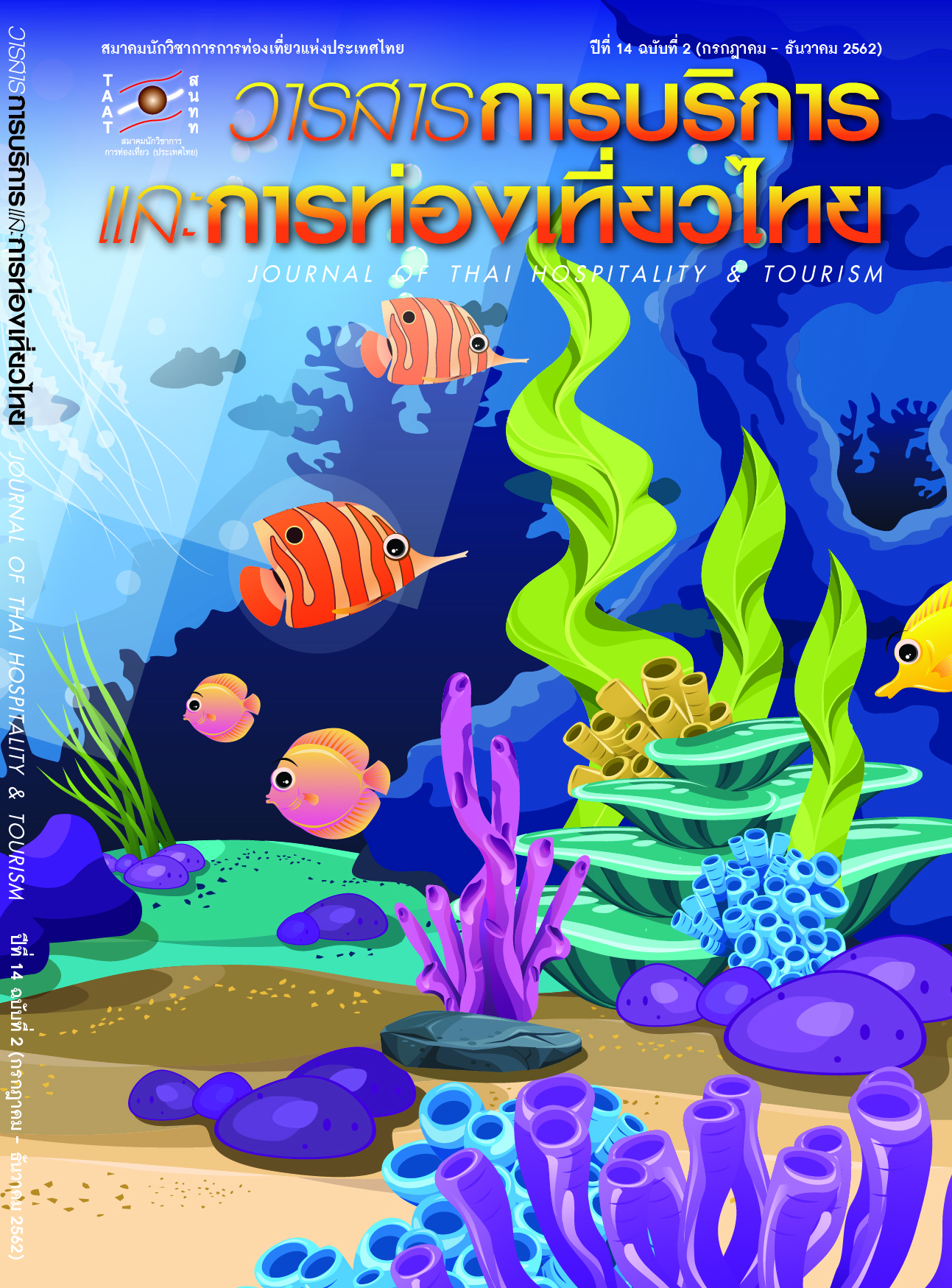The Adaptation of Low-Cost Airline Business Model in Thailand: The Consequences of Competitive Pressures and Challenges
Main Article Content
Abstract
This academic article aims to study the adaptation of business models and strategies by low-cost airline business in Thailand. By adopting hybrid strategies, low-cost airlines incorporate some service characteristics, product features and operations of full-service airlines into their attributes. This article also attempts to understand the factors influencing those changes which resulted from the challenges, obstacles, and concerns that the airline industry faces as a result of increasingly fierce competition, especially in terms of costs. It is widely known that price strategy is common among low-cost airlines due to its easy implementation and quick results. Nonetheless, many scholars have argued that such a strategy does not contribute to sustainable competitive advantage and profitability. Consequently, low-cost airlines, both in Thailand and worldwide, must adapt in order to survive in a rapidly changing market. The final section of this article offers appropriate strategies that low-cost airlines should consider to lessen the impacts of those challenges and avoid price competition, in order to achieve true business sustainability.
Article Details
References
[2] Akamavi, R. K., Mohamed, E., Pellmann, K., & Xu, Y. (2015). Key Determinants of Passenger Loyalty in the Low-Cost Airline Business. Tourism Management, 46, 528-545.
[3] AOT. (2016a). Annual Report 2015 - Airports of Thailand Public Company Limited. Retrieved July 18, 2016, from https://aot.listedcompany.com/misc/AR/20160112-aot-ar-2015-en.pdf.
[4] AOT. (2016b). AOT Air Traffic Calendar Year 2016 (Jan-Dec 2016). Retrieved March 03, 2017, from https://aot.listedcompany.com/misc/statistic/2017/20170123-aot-traffic-calendar-2016-12m.pdf.
[5] AOT. (2016c). AOT LCCs Air Traffic Calendar Year 2016. Retrieved March 15, 2017, from https://aot.listedcompany.com/misc/statistic/2016/20161025-aot-lccs-traffic-fiscal-2016.xlsx.
[6] Asia Aviation. (2015). Annual Report 2015. Retrieved June 07, 2015, from https://aav.listedcompany.com/misc/AR/20160404-aav-ar2015-en.pdf.
[7] Association of Asia Pacific Airlines. (2016). Asia Pacific Airlines Traffic Results – May 2016. Retrieved June 28, 2016, from https://www.aapairlines.org/resource_centre/AAPA_PR_Issue09_MayTrafficResults_28Jun16.pdf.
[8] Boeing. (2015). Current Market Outlook 2015–2034. Retrieved July 15, 2016, from https://www.boeing.com/resources/boeingdotcom/commercial/about-our-market/assets/downloads/Boeing_Current_Market_Outlook_2015.pdf.
[9] Centre for Aviation. (2012). AirBerlin Joins Oneworld Alliance, But Its Full Potential will not be Immediately Realised. Retrieved June 18, 2016, from https://centreforaviation.com/analysis/airberlin-joins-oneworld-alliance-but-its-full-potential-will-not-be-immediately-realised-70096.
[10] CNN.com. (2016). Low-Cost Airlines: They Changed the World -- But What Next?. Retrieved June 18, 2016, from https://edition.cnn.com/2016/03/20/aviation/budget-airline-trends-2016/.
[11] Department of Airport. (2016). Air Transport Traffic at DCA’s Domestic Airport in 2016. Retrieved March 15, 2017, from https://www.airports.go.th/th/content/349/1394.html.
[12] Doganis, R. (2010). Flying Off Course: Airline Economics and Marketing. 4th ed. New York Routledge.
[13] Francis, G., Humphreys, I., Ison, S., & Aicken, M. (2006). Where Next For Low-Cost Airlines? A Spatial and Temporal Comparative Study. Journal of Transport Geography, 14(2), 83-94.
[14] Gilbert, D. (1996). Relationship Marketing and Airline Loyalty Schemes. Tourism Management, 17(8), 575-582.
[15] Han, H., Hyun, S. S., & Kim, W. (2014). In-flight Service Performance and Passenger Loyalty: A Cross-National (China/Korea) Study of Travelers Using Low-cost Carriers. Journal of Travel & Tourism Marketing, 31(5), 589-609.
[16] IATA. (2011). Vision 2050 – Shaping Aviation’s Future. Retrieved June 30, 2016, from https://www.iata.org/pressroom/facts_figures/Documents/vision-2050.pdf.
[17] ICAO. (2015). Continuing Traffic Growth and Record Airline Profits Highlight 2015 Air Transport Results. Retrieved July 15, 2016, from https://www.icao.int/Newsroom/Pages/Continuing-Traffic-Growth-and-Record-Airline-Profits-Highlight-2015-Air-Transport-Results.aspx.
[18] Klophaus, R., Conrady, R., & Fichert, F. (2012). Low-Cost Carriers Going Hybrid: Evidence From Europe. Journal of Air Transport Management, 23, 54-58.
[19] Lawton, T. C. (2003). Managing Proactively in Turbulent Times: Insights from the Low-fare Airline Business. Irish Journal of Management, 24(1), 173.
[20] Lück, M., & Gross, S. (2013). Low-Cost Carrier Worldwide: Ashgate Publishing Ltd.
[21] Mikulić, J., & Prebežac, D. (2011). What drives Passenger Loyalty to Traditional and Low-cost Airlines? A Formative Partial Least Squares Approach. Journal of Air Transport Management, 17(4), 237-240.
[22] Nadiri, H., Hussain, K., Haktan Ekiz, E., & Erdogan, S. (2008). An Investigation On the Factors Influencing Passengers' Loyalty in the North Cyprus National Airline. The TQM Journal, 20(3), 265-280.
[23] Nok Air. (2015). Travel Classes. Retrieved June 14, 2016, from https://www.nokair.com/contents/on_board/travel_class/en-US/index.html.
[24] Nok Air. (2016). Annual Report 2015. Retrieved June 07, 2016, from https://nok.listedcompany.com/ar.html.
[25] Ostrowski, P. L., O'Brien, T. V., & Gordon, G. L. (1993). Service Quality and Customer Loyalty in the Commercial Airline Industry. Journal of Travel Research, 32(2), 16-24.
[26] Prachachart Turakij Online. (2017). Don Muang Airport – Expanding Phase 3 to increase its Capacity From 35 Million to 40 Million Passengers per Year. Retrieved March 15, 2017, from https://www.prachachat.net/news_detail.php?newsid=1489495623.
[27] Schlumberger, C. E., & Weisskopf, N. (2014). Ready for Takeoff?: The Potential for Low-cost Carriers in Developing Countries: World Bank Publications.
[28] Taneja, N. K. (2014). Designing Future-oriented Airline Businesses. Burlington, VT: Burlington, VT: Ashgate.
[29] Thai AirAsia. (2016). Fare Types. Retrieved June 14, 2016, from https://www.airasia.com/th/en/our-fares/fare-types.page.
[30] Thai Airways. (2016). Annual Report 2015. Retrieved Dec 4, 2016, from https://thai.listedcompany.com/misc/ar/20160325-thai-ar2015-en.pdf.
[31] Thai Lion Air. (2016). Terms and Conditions. Retrieved June 14, 2016, from https://www.lionairthai.com/en/Terms-And-Conditions.
[32] Thai Smile Air. (2016). Terms & Conditions. Retrieved June 14, 2016, from https://www.thaismileair.com/en/Terms-and-Conditions.

